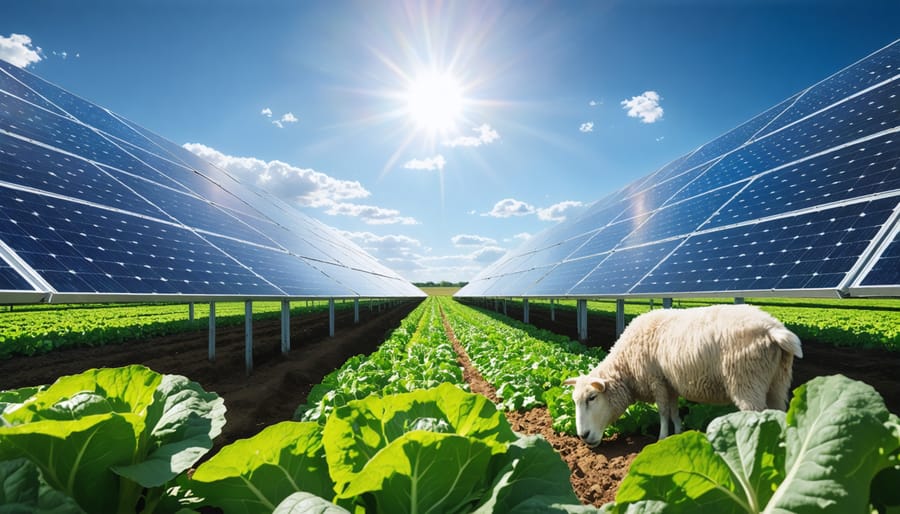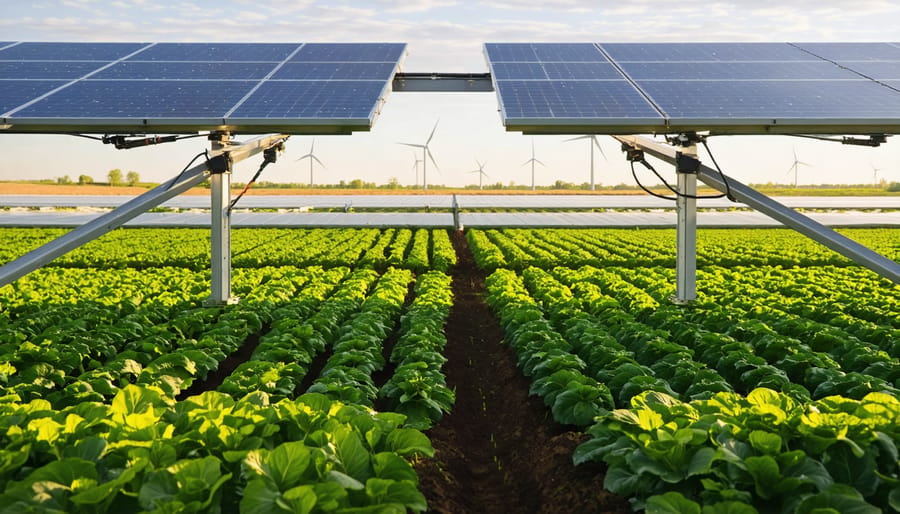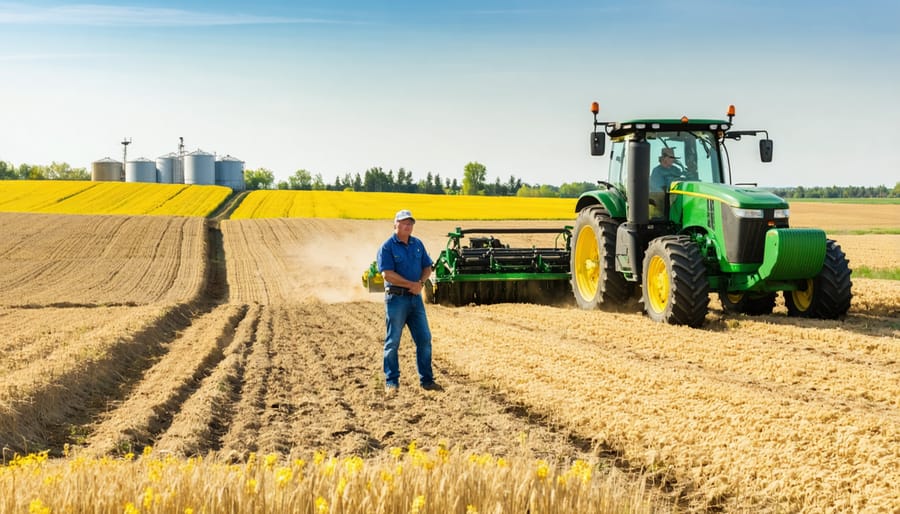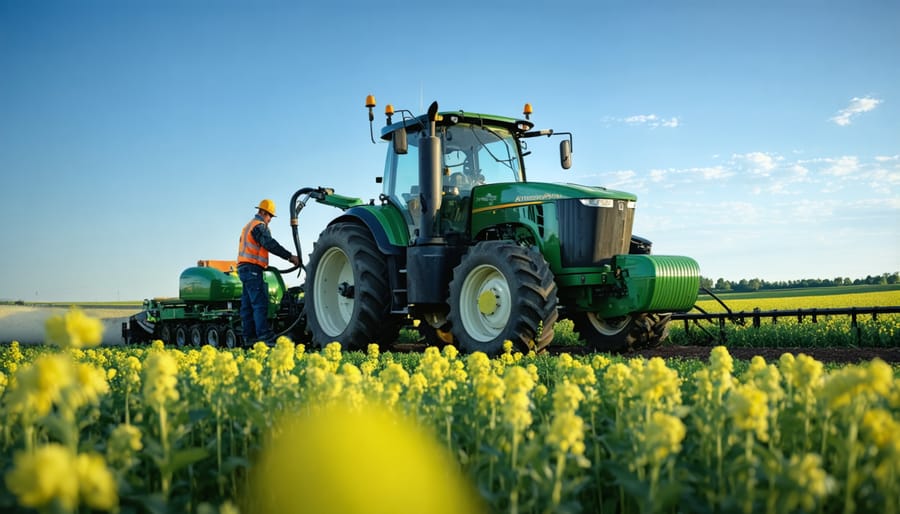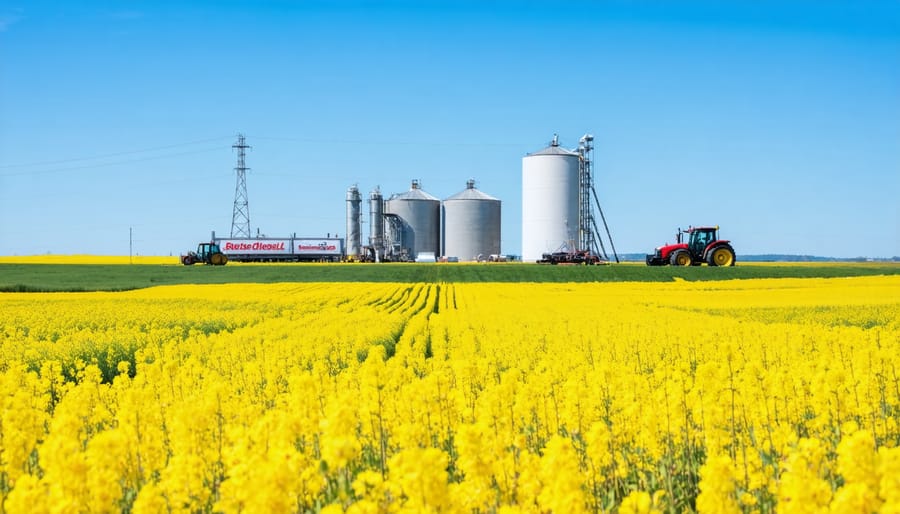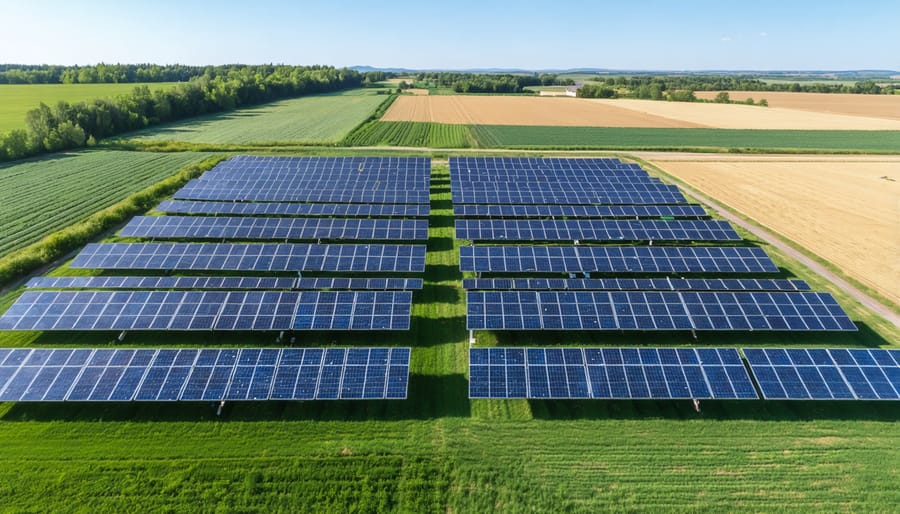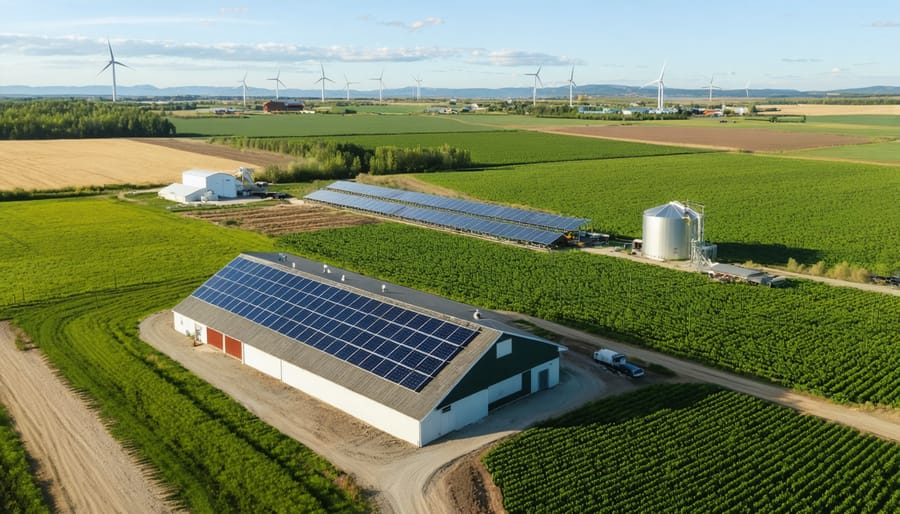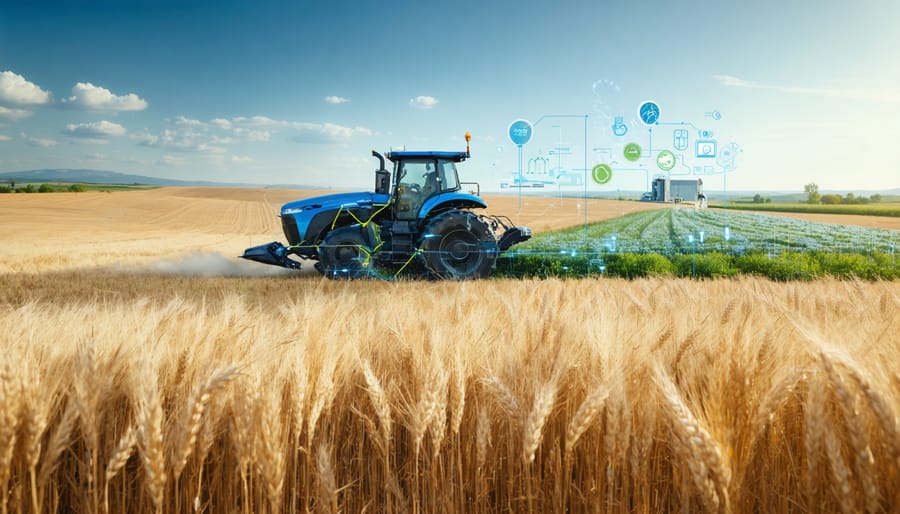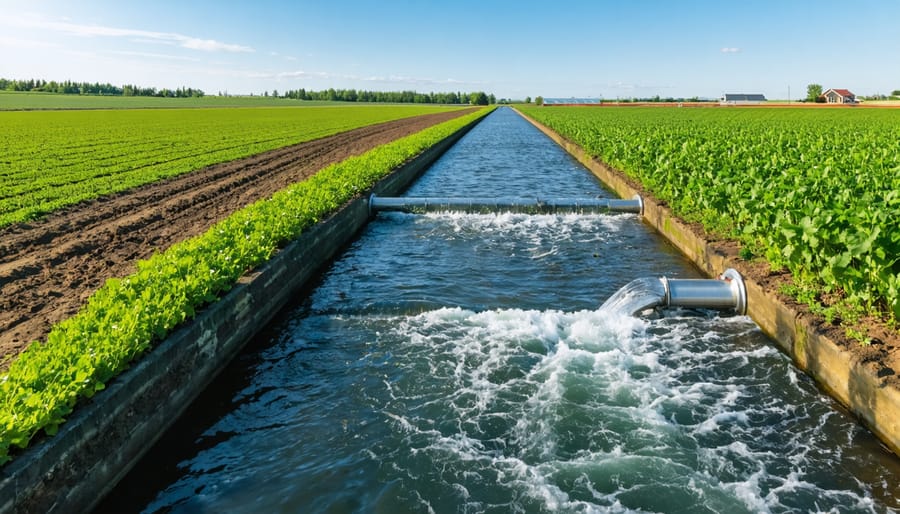Imagine harvesting both sunlight and crops from the same plot of land – this is the revolutionary potential of agrivoltaics transforming Canadian agriculture. Across Alberta’s sun-rich prairies, innovative farmers are discovering that solar panels and traditional farming aren’t just compatible; they’re complementary. Solar arrays strategically positioned above cropland create microclimates that reduce water evaporation by up to 30%, while providing valuable shade for heat-sensitive crops. These dual-use systems generate clean energy income alongside traditional agricultural revenue, offering farmers a practical path to diversification and resilience.
Recent studies from Canadian agricultural research stations demonstrate that certain crops, particularly leafy greens and root vegetables, thrive in the partial shade of solar installations, showing yield increases of 15-25% compared to conventional farming methods. For livestock operators, solar arrays provide shelter for grazing animals while generating enough electricity to power entire farm operations. This integration of agriculture and renewable energy isn’t just about sustainability – it’s about creating a more profitable and resilient future for Canadian farming communities.
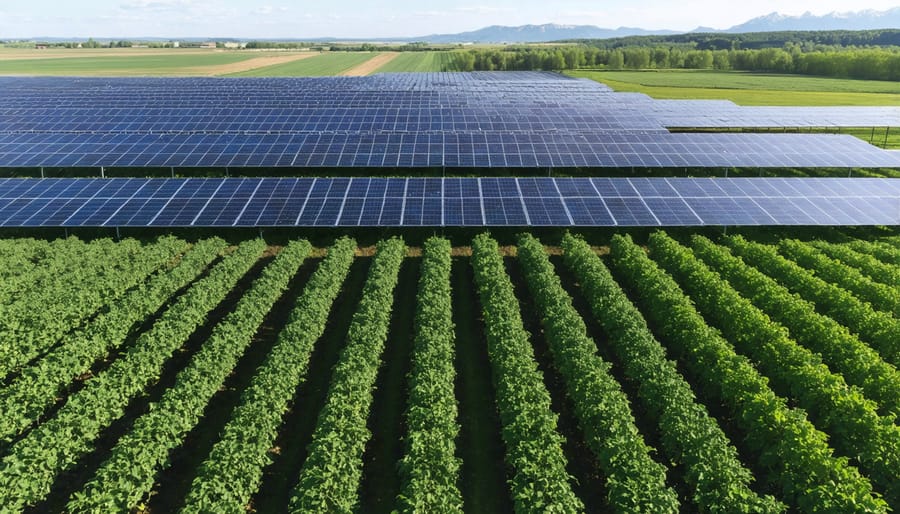
Agrivoltaics: A Game-Changer for Alberta Farmers
How Solar Panels Protect Your Crops
Solar panels do more than just generate clean energy – they’re also powerful crop protectors. Here in Alberta, where weather can be unpredictable, solar panels create beneficial microclimates for crops growing beneath them. The panels provide strategic shade that reduces water evaporation by up to 25%, helping crops thrive during our hot summer months while conserving precious water resources.
During intense storms, these sturdy structures shield delicate plants from damaging hail and heavy rainfall. Local farmer Sarah Thompson from Lethbridge notes, “Since installing our agrivoltaic system, we’ve seen significantly less crop damage during severe weather events, especially with our sensitive leafy greens.”
The shade patterns created by solar panels also help regulate soil temperature, protecting root systems from extreme heat and cold. This temperature moderation extends the growing season for many crops, particularly in Southern Alberta. Research from the University of Alberta shows that some shade-tolerant crops grown under solar panels demonstrate increased yields of 10-15% compared to traditional field cultivation.
In winter months, the panels help trap heat and reduce frost damage, while their presence can break harsh winds that typically damage young plants.
Ideal Crops for Solar Farm Integration
Several crops have proven successful in Alberta’s agrivoltaic systems, adapting well to the partial shade conditions created by solar panels. Leafy greens like spinach, kale, and Swiss chard thrive particularly well, often showing improved quality and reduced water needs compared to full-sun cultivation. These crops benefit from protection against harsh summer sun while maintaining productive growth rates.
Root vegetables, including carrots and potatoes, have also demonstrated strong performance in solar-sharing environments. The moderate shade can actually help prevent soil moisture loss, leading to more consistent growing conditions. Many Alberta farmers have reported success with cool-season herbs such as mint, oregano, and thyme, which naturally prefer partially shaded conditions.
For larger-scale operations, certain forage crops like alfalfa and specific varieties of grass have shown promising results. These crops not only provide valuable livestock feed but also help maintain soil health beneath the solar installations. Local trials have even shown some berry crops, particularly saskatoons and haskap, adapting well to the partial shade conditions, offering farmers additional high-value crop options.
When selecting crops, consider those with lower height profiles to prevent interference with panel efficiency. Start with small test plots to determine which varieties work best in your specific microclimate.
Real Results from Alberta Solar Farms
The Brooks Solar Farm Success Story
Among the many success stories from Alberta farmers, the Brooks Solar Farm stands out as a shining example of agricultural innovation. Located just east of Brooks, Alberta, this 68-hectare operation seamlessly combines solar energy production with active farming, demonstrating how dual-land use can benefit both sectors.
Farmer James Morrison, who initiated the project in 2019, maintains a thriving sheep grazing operation among the solar panels. His flock of 200 sheep effectively manages vegetation while producing high-quality lamb for local markets. The solar installation generates 15 megawatts of clean electricity, enough to power 3,000 homes, while the land continues to support agricultural production.
The project has yielded impressive results: a 15% reduction in maintenance costs compared to conventional vegetation management, increased soil fertility from natural fertilization, and a steady additional income stream from power generation. Morrison reports that lamb production has remained consistent, with the added benefit of shade from the panels protecting his flock during intense summer heat.
Local agricultural extension services have documented improved soil moisture retention beneath the panels, leading to better pasture quality in the typically arid region. The project has become a model for other farmers in southern Alberta, demonstrating that solar farms can coexist with and even enhance traditional agricultural practices.
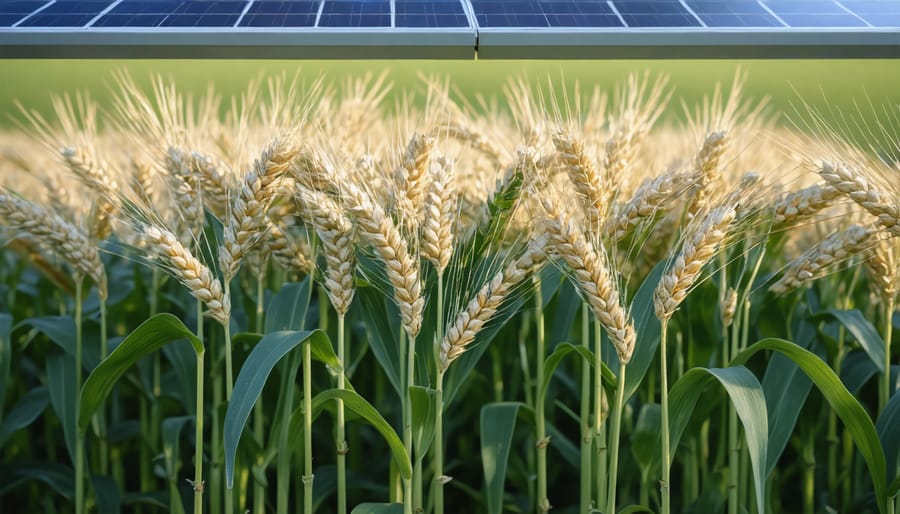
Yield Data and Energy Savings
Recent studies from Alberta’s solar-agriculture projects demonstrate impressive dual-yield potential. At the Mountain View Solar Farm, farmers reported maintaining 85-90% of their original crop yields while generating approximately 1.2 megawatts of clean energy per hectare annually. This translates to powering roughly 400 local homes while continuing productive agricultural operations.
In terms of energy savings, participating farms have seen their operational costs decrease by 30-45% on average. A notable case study from Lethbridge County showed that a 160-acre mixed solar-agriculture operation generated $175,000 in annual energy revenue while maintaining $120,000 in crop yields from the same land.
The numbers are particularly encouraging for livestock operations. Sheep grazing between solar panels has proven highly effective, with farmers reporting stocking rates of 2-3 sheep per acre – comparable to traditional pasture management. These dual-use systems have shown a 15-20% increase in soil moisture retention under panels, leading to better forage quality during dry periods.
For crop farmers, innovative spacing techniques have allowed for successful cultivation of low-growing plants like potatoes and legumes. Data from the Prairie Agricultural Research Institute shows these arrangements can achieve 95% of traditional crop yields while generating 800-850 kilowatt-hours of electricity per square metre annually.
These figures demonstrate that solar farming isn’t just environmentally conscious – it’s a viable strategy for diversifying farm income while maintaining agricultural productivity.
Getting Started with Solar Farming
Site Assessment and Planning
Before establishing a solar farm alongside agricultural operations, thorough site assessment and planning are essential for success. Start by evaluating your land’s solar potential through a professional assessment of sunlight exposure, considering factors like shade patterns and seasonal variations typical in Alberta’s climate.
Key considerations include soil quality assessment, drainage patterns, and existing agricultural activities. Ideal locations often include marginal farmland or areas where solar irrigation systems can be efficiently integrated with crop production.
Work with local agricultural extension offices to develop a comprehensive site plan that maintains productive farming while maximizing solar potential. Consider factors like panel height and spacing to accommodate machinery access and ensure adequate light reaches crops in shared spaces.
Your assessment should also include:
– Connection proximity to the power grid
– Local zoning requirements and permits
– Access roads for maintenance
– Water management strategies
– Seasonal crop rotation patterns
Remember to engage early with neighboring farmers and your local agricultural community to address concerns and share insights about dual-use farming practices.
Available Grants and Support
Several funding programs are available to support Alberta farmers interested in integrating solar installations with their agricultural operations. The Canadian Agricultural Partnership (CAP) offers grants covering up to 50% of eligible costs for sustainable agriculture projects, including agrivoltaic systems. In Alberta, the Farm Energy and Agri-Processing Program (FEAP) provides funding specifically for on-farm solar installations, with coverage of up to $250,000 per project.
Local agricultural societies and Rural Electrification Associations (REAs) often provide additional support through technical guidance and community-based funding initiatives. The Alberta Solar Municipal Resource Hub offers free consultations and feasibility studies for farmers considering solar installations.
For technical support, the Agriculture Financial Services Corporation (AFSC) provides specialized loans with favorable terms for sustainable farming projects. Additionally, the Environmental Farm Plan (EFP) program offers one-on-one support to help farmers assess opportunities and develop implementation strategies for solar integration.
Farmers can also access expertise through Alberta Agriculture and Forestry’s network of specialists, who provide guidance on project planning, permitting processes, and optimal system design for agricultural applications.
Working with Solar Installers
Choosing the right solar installation company is crucial for the success of your agrivoltaic project. In Alberta, start by verifying that potential installers are members of the Solar Alberta Association and have experience with agricultural installations. Look for companies that understand both solar technology and farming operations, as this dual expertise is essential for optimal system design.
Request references from other farmers who have implemented similar projects and arrange site visits to existing agrivoltaic installations. Reputable installers should provide detailed proposals including system specifications, expected energy production, and clear timelines that accommodate your agricultural calendar.
When evaluating quotes, consider more than just the initial cost. Ask about maintenance plans, warranty coverage, and their experience with securing permits and navigating utility connections in rural areas. The best installers will help you understand available grants and incentives under Alberta’s renewable energy programs.
Look for companies that offer post-installation support and monitoring services. They should be willing to train your farm staff on basic system operations and safety protocols. Many leading installers in Alberta now provide remote monitoring capabilities, allowing you to track system performance from your smartphone or computer.
Before signing any contracts, ensure all terms are clearly outlined, including project milestones, payment schedules, and performance guarantees. Consider working with installers who have partnerships with local agricultural equipment suppliers, as this can streamline future maintenance and repairs.
Environmental and Economic Benefits
Carbon Footprint Reduction
Recent studies from Alberta’s solar-agriculture projects show remarkable progress in reducing carbon emissions. A typical 1-megawatt solar installation combined with continued farming operations can offset approximately 1,100 tonnes of CO2 annually – equivalent to taking 240 cars off the road. When we factor in the agricultural activities beneath the panels, these dual-use systems provide an additional 15-20% reduction in farm-related emissions through decreased water evaporation and reduced machinery use.
In the Vulcan County solar farm, where sheep grazing has been integrated with solar operations, farmers have reported a 30% reduction in their overall carbon footprint compared to traditional farming methods. This includes savings from reduced mowing requirements and natural fertilization from the grazing animals.
The environmental benefits extend beyond carbon reduction. Solar farms in Southern Alberta have shown to prevent approximately 800 kg of nitrogen oxide emissions per megawatt annually. Additionally, the shade provided by panels has helped reduce soil moisture loss by up to 25%, leading to decreased irrigation needs and associated energy consumption.
According to Agriculture Canada’s recent assessment, farms combining solar and agricultural activities typically achieve carbon neutrality within 4-6 years of operation, compared to the 8-10 years for standalone solar installations. This faster carbon payback period makes agrivoltaics particularly attractive for farmers looking to meet Alberta’s emissions reduction targets while maintaining productive agricultural operations.
Long-term Financial Returns
The financial benefits of solar farming in Alberta present a compelling case for long-term investment. Based on current data from regional solar installations, farmers can expect to recoup their initial investment within 8-12 years, depending on system size and local conditions. After this period, the solar infrastructure continues generating revenue for an additional 15-20 years with minimal maintenance costs.
Local case studies show that a typical 1-megawatt solar installation on 2-3 hectares can generate annual revenues between $90,000 and $120,000 through power purchase agreements. When combined with continued agricultural activities like sheep grazing or shade-tolerant crop cultivation, the land can maintain up to 70% of its original farming revenue while adding this new income stream.
The Alberta Solar Investment Program offers grants covering up to 35% of installation costs, significantly improving ROI calculations. Additionally, farmers report reduced irrigation needs for certain crops grown under panels, resulting in water cost savings of 20-30% annually. Property value assessments indicate that farms with solar installations typically see a 10-15% increase in land value.
Many Alberta farmers have negotiated 25-year fixed-rate power purchase agreements, providing stable, predictable income that helps offset agricultural market fluctuations. This diversification strategy has proven particularly valuable during challenging growing seasons, offering financial stability when traditional crop yields are impacted by weather events.
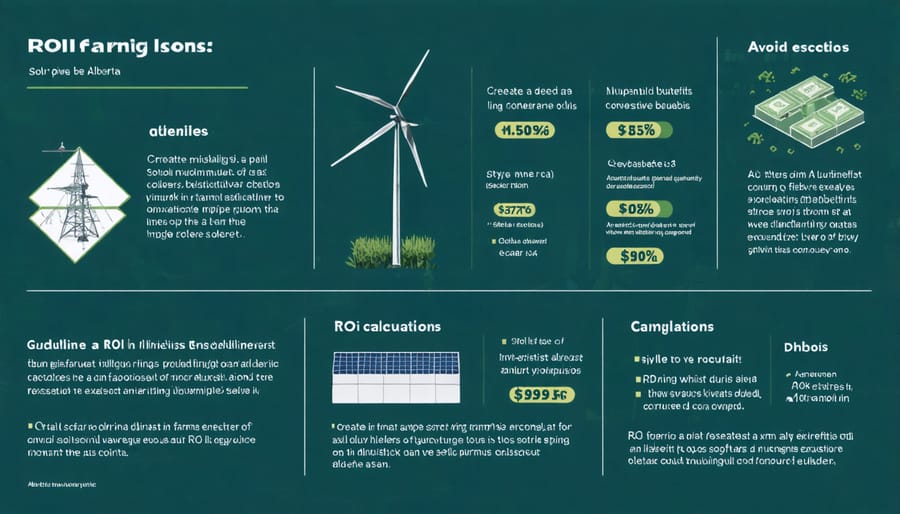
The integration of solar farming with traditional agriculture represents a promising opportunity for Canadian farmers to diversify their income while maintaining productive agricultural operations. Throughout Alberta, we’ve seen numerous success stories of farmers who have embraced this dual-use approach, successfully balancing crop production or livestock grazing with clean energy generation.
The evidence is clear: solar farms can coexist with and even enhance agricultural practices when properly implemented. From increased soil moisture retention under panels to the creation of beneficial microclimates for certain crops, the benefits extend beyond simply generating additional revenue. Moreover, the stable income from solar leases provides financial security during challenging agricultural seasons.
As we look to the future of farming in Canada, the solar-agriculture combination offers a sustainable path forward. The growing demand for renewable energy, coupled with government incentives and support programs, makes this an opportune time for farmers to explore solar farming options. Local agricultural extension offices and renewable energy associations stand ready to help farmers navigate the planning and implementation process.
We encourage you to take the first step by reaching out to fellow farmers who have already integrated solar installations on their land. Their experiences and insights can provide valuable guidance as you consider this opportunity for your own operation. Remember, you’re not just investing in energy production – you’re investing in the long-term sustainability and resilience of your farm.

